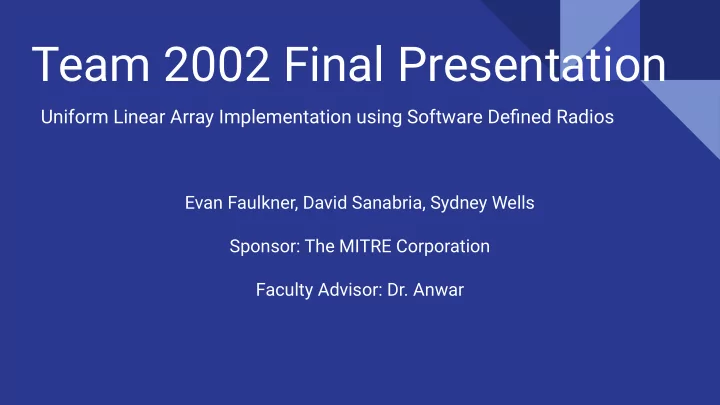

Team 2002 Final Presentation Uniform Linear Array Implementation using Software Defined Radios Evan Faulkner, David Sanabria, Sydney Wells Sponsor: The MITRE Corporation Faculty Advisor: Dr. Anwar
Background Underwater communication has numerous applications [1] ● The most common solution is to use acoustics [1] ● The underwater acoustic channel presents several challenges [2] ● Beamforming is one of many viable strategies to combat these issues [3] ●
Peter Willett. ECE 6123 Advanced Signal Processing. Lecture Notes, “Spectral Estimation.” Department of Electrical and Computer Engineering, University of Connecticut, Fall 2017.
Project Goals ● Develop the capability to prototype a Uniform Linear Array (ULA) on a Software Defined Radio (SDR) platform in a lab environment ● Demonstrate the ability to steer transmissions and receptions using multiple hydrophone elements ● Evaluate beamforming capability using SDR hardware and wired connections
Design Considerations ● Beamformer design Time domain vs. frequency domain beamforming ○ ○ Element spacing Number of elements ○ ○ Windowing Steering and Nulling ○ ● SDR Implementation ○ Must run in real time ○ Ettus X310 supports 2 TX channels or 4 RX channels
Hardware ● Provided by MITRE ● Two Ettus X310 USRP software defined radios to send and receive real signals ○ Two wide-bandwidth daughterboards slots C++/Python driver support ○ Two UDOO x86 boards to operate as ● Host Computers ○ Windows, Linux, and Android compatible
Technical Solution Phase 1 MATLAB development of beamforming capability in simulated channels ○ AWGN and Stojanovic channels adapted for use with arrays Custom time domain and ○ frequency domain beamformers ○ Testing beamformers for transmission and reception of QPSK signals over AWGN and Stojanovic acoustic channels
Technical Solution Phase 2 Creation of a beamforming application for Ettus X310 SDRs ○ C++ development ○ 2 element transmitter arrays, 4 element receiver arrays Adjustable parameters for windowing, number of elements, sampling rate ○ ○ Unit testing to verify performance is as expected under a range of operating conditions ○ Testing transmitter and receiver beamforming over simulated channels Multi-in Multi-out (MIMO) transmission and reception with USRPs ○
Beamforming Class ● A beamforming class was developed in C++ A beamformer object is instantiated with the desired geometry ● Methods for transmission and reception in any direction have been developed ● ○ High sampling rates are assumed allowing use of integer sample delays ○ Transmission takes a single input and generates multiple transmission vectors Reception takes multiple received vectors and outputs a single steered ○ reception vector ● Arbitrary weights can be applied across the array with built-in normalization of the weight vector
Beamforming Results
Spring 2020 Project Timeline
RACI Chart Evan Sydney David MITRE Dr. Anwar R R R A I Matlab Development R R I A I Beamforming R I R A I Rician/Autoregressive Channel I R R A I C++ SDR Development R R R A I Acoustic Communications Research I I I R I Stojanovic Acoustic Channel R R R C A Reports and Presentations
References 1) Shengli Zhou and Zhaohui Wang, OFDM for Underwater Acoustic Communications , Hoboken, NJ: John Wiley and Sons, 2014. [E-book] Available: https://learning.oreilly.com/library/view/ofdm-for-underwater/9781118693810/. [Accessed Oct. 17, 2019]. 2) John Heidemann, Milica Stojanovic, and Michele Zorzi, “Underwater sensor networks:applications, advances, and challenges,” Philosophical Transactions of the Royal Society A: Mathematical, Physical and Engineering Sciences , vol. 370, issue 1958, pp. 158-175. [Online]. Available: https://royalsocietypublishing.org/doi/pdf/10.1098/rsta.2011.0214. [Accessed Oct. 16, 2019]. 3) H. L. V. Trees, Optimum Array Processing . New York: John Wiley and Sons, 2002, p. 1-8. 4) Amy Nordrum, “Nato Unveils JANUS, First Standardized Acoustic Protocol for Undersea Systems,” IEEE Spectrum , Jul 17, 2007. [Online]. Available: https://spectrum.ieee.org/tech-talk/telecom/wireless/nato-develops-first-standardized-acoustic-sign al-for-underwater-communications. [Accessed Oct. 16, 2019].
References 5) F. Jia, E. Cheng and F. Yuan, "The study on time-variant characteristics of under water acoustic channels," 2012 International Conference on Systems and Informatics (ICSAI2012) , Yantai, 2012, pp. 1650-1654. [Online]. Available: https://ieeexplore.ieee.org/document/6223357. [Accessed on Oct 16, 2019]. 6) J. A. Catipovic, "Performance limitations in underwater acoustic telemetry," in IEEE Journal of Oceanic Engineering , vol. 15, no. 3, pp. 205-216, July 1990. [Online]. Available: https://ieeexplore.ieee.org/document/107149. [Accessed on Oct 17, 2019]. 7) Thesis: Eggen, Trym H., "Underwater acoustic communication over Doppler spread channels", 1997-06, DOI:10.1575/1912/5709, https://hdl.handle.net/1912/5709
Recommend
More recommend